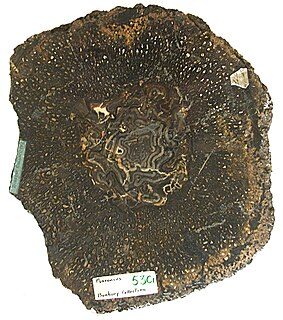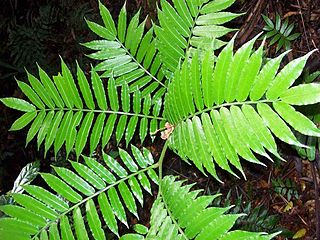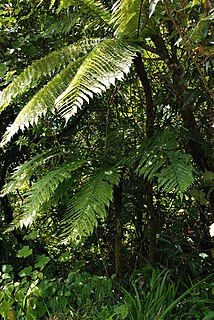
A fern is a member of a group of vascular plants that reproduce via spores and have neither seeds nor flowers. They differ from mosses by being vascular, i.e., having specialized tissues that conduct water and nutrients and in having life cycles in which the sporophyte is the dominant phase. Like other vascular plants, ferns have complex leaves called megaphylls, that are more complex than the microphylls of clubmosses. Most ferns are leptosporangiate ferns, sometimes referred to as true ferns. They produce coiled fiddleheads that uncoil and expand into fronds. The group includes about 10,560 known extant species.

The order Marattiales is a group of ferns containing the single family, Marattiaceae. with six extant genera and a total of c. 135 known species.

The order Cyatheales, which includes the tree ferns, is a taxonomic division of the fern class, Polypodiopsida. No clear morphological features characterize all of the Cyatheales, but DNA sequence data indicate the order is monophyletic. Some species in the Cyatheales have tree-like growth forms, but others have rhizomes.

Cyathea dealbata, commonly known as the silver fern or silver tree-fern, or as ponga or punga, is a species of medium-sized tree fern, endemic to New Zealand. The fern is usually recognisable by the silver-white colour of the under-surface of mature fronds. It is a symbol commonly associated with the country both overseas and by New Zealanders themselves.

Platycerium is a genus of about 18 fern species in the polypod family, Polypodiaceae. Ferns in this genus are widely known as staghorn or elkhorn ferns due to their uniquely shaped fronds. This genus is epiphytic and is native to tropical and temperate areas of South America, Africa, Southeast Asia, Australia, and New Guinea.

Dicksonia antarctica is a species of evergreen tree fern native to eastern Australia, ranging from south-east Queensland, coastal New South Wales and Victoria to Tasmania.

Cyathea cooperi, also known as the Australian tree fern, lacy tree fern, scaly tree fern, or Cooper's tree fern, is a tree fern native to Australia, in New South Wales and Queensland.

Dicksonia squarrosa, commonly called whekī or rough tree fern, is a common tree fern endemic to New Zealand. It has a slender black trunk that is usually surrounded by many dead brown fronds.

Cyathea dregei is a widespread species of tree fern in southern Africa.

Cyathea smithii, commonly known as the soft tree fern or kātote, is a species of tree fern from New Zealand.

Psaronius was a Marattialean tree fern which grew to 10m in height, and is associated with leaves of the organ genus Pecopteris and other extinct tree ferns. Originally, Psaronius was a name for the petrified stems, but today the genus is used for the entire tree fern. Psaronius tree fern fossils are found from the Carboniferous through the Permian.

Polypodium glycyrrhiza, commonly known as licorice fern, many-footed fern, and sweet root, is a summer deciduous fern native to western North America, primarily in a narrow strip in southern Alaska, southwestern Yukon Territory, western British Columbia, Washington, Oregon, and California, though two highly disjunct populations are known from Idaho and Arizona. It thrives in a humid climate, prevailing in areas with cool and moist summers and warm and wet winters. P. glycyrrhiza can often be found growing on the trunks and branches of winter deciduous trees, particularly bigleaf maple, but is also often found on rocks, logs, and wet, mossy humus. It takes advantage of the mild, wet winters and the substrate of deciduous trees to photosynthesize and grow during the cold season when most other temperate plants are dormant. Habitat elevation is lowlands below 600 meters.
Cyathea macgregorii is a species of tree fern in the family Cyatheaceae. Its trunk is approximately 3 meters tall and about 24 centimeters thick. It has narrow and tripinnate fronds which are about 1 meter long, occurring in clusters of approximately 60, and form a round crown. The stipe is scaly and warty, scales being either smooth and shiny brown or small and pale. The sori are in groups of four to six in pinnule lobes. They are covered in brown indusia. It bears similarity to Cyathea imbricata and even greater similarity to Cyathea gleichenioides. It is possible that these variations are only due to differences in habitat and they may be same species.

Cyathea sinuata is unique among the tree ferns in that it has entire leaves, not pinnate or lobed. It is native to Sri Lanka but rare, being only known from one local forest area. It is one of the smallest species of tree ferns, growing only about one meter tall, with fronds 60 to 90 centimeters long.

Angiopteris evecta, commonly known as the giant fern, is a rare plant occurring in eastern and northern Australia and the Malay Peninsula. Also found growing in nearby islands such as Borneo, Sumatra, New Guinea and various places in Polynesia, Melanesia and Madagascar. Listed as endangered in New South Wales, where it has been recorded growing in sub tropical rainforest, in the valley of the Tweed River. It is an invasive species in Hawaii and Jamaica.
Elaphoglossum serpens is a rare species of fern that grows only on Cerro de Punta, the highest mountain in Puerto Rico. The fern grows at one location, where there are 22 known specimens. It was federally listed as an endangered species of the United States in 1993.

Cyathea borbonica is a tree fern endemic to Mauritius, Réunion and the islands of the south-western Indian Ocean. There are several natural forms and varieties.

















